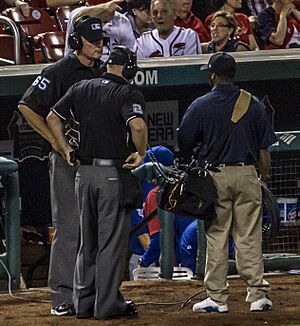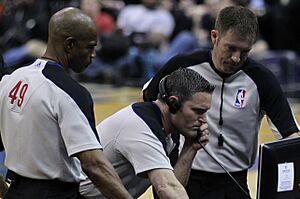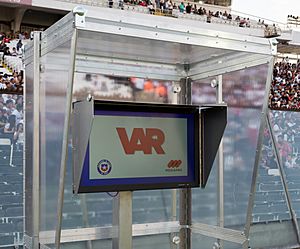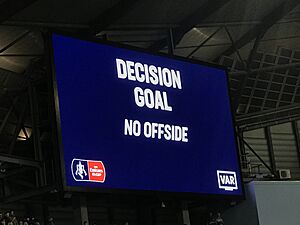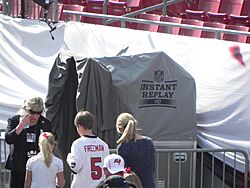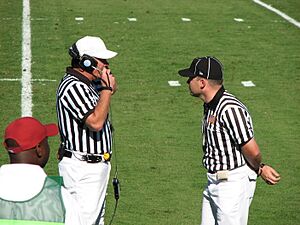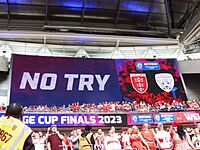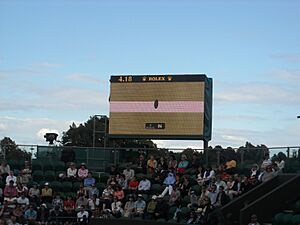Instant replay facts for kids
Instant replay is when a video of something that just happened live on TV is shown again. It's like pressing rewind and play right away! This lets viewers see important moments again and understand what happened.
Instant replay is used a lot in sports. For example, in American football, soccer, Badminton, cricket, and tennis, officials can use replays to check if a call was correct. While sports are the most common place, instant replay is also used in other live TV shows.
The first system that was almost an instant replay was made in Canada. But the very first *true* instant replay system was created and used in the United States.
Besides sports, instant replay is also used for big events like parades with important people (like kings or queens), political debates, royal weddings, or big award shows like the Oscars. It's helpful because these events are often too big to see everything from one camera, or they happen too fast to catch every detail the first time.
In the past, TV channels usually showed one video feed to everyone. But now, with streaming media, you can often watch live events with many different video streams at once. You can even rewind, watch in slow motion, or stop the action yourself!
Contents
History of Instant Replay
In 1955, during a Hockey Night in Canada show on CBC Television, a producer named George Retzlaff used a "wet-film" replay. This replay aired a few minutes after the live action.
Then, in 1956, videotape was invented. But early videotape machines couldn't do slow motion, instant replay, or freeze frames easily.
A few minutes after a boxing match on March 24, 1962, between Benny Paret and Emile Griffith, the end of the fight was reviewed in slow motion. Many people say this was the first time slow motion replay was used on TV.
The first *true* instant replay system was invented by CBS Sports Director Tony Verna. He created a way for a regular videotape machine to replay something instantly. This happened on December 7, 1963, during the Army–Navy Game football broadcast. His machine was very big, weighing about 1,300 pounds (590 kg)! The first replay shown was a touchdown by Rollie Stichweh. It was played at normal speed, and the announcer Lindsey Nelson joked, "Ladies and gentlemen, Army did not score again!" Verna's system helped technicians find the right spot on the tape quickly.
Later, in 1965, CBS tried out replay from analog disk storage. This was then sold to the public in 1967 as the Ampex HS-100, which could hold 30 seconds of video and do freeze frames.
Instant replay really helped make televised American football popular. Before instant replay, it was hard for viewers to understand what was happening on a small, black-and-white TV screen. But with replay, viewers could see close-ups of important plays in slow motion. This made "brutal collisions become ballets," as one writer said, and made football plays look like "miracles of human coordination." Thanks to instant replay, football became popular evening entertainment, especially with shows like ABC-TV's Monday Night Football.
Instant Replay in Sports TV
When sports events are shown live on TV, instant replay is often used to show an important or exciting moment again. It's also used for plays that were hard to see clearly the first time.
Replays are usually shown when there's a break in the game. They might be in slow motion or show the action from different camera angles.
Modern video servers allow for even cooler replays. They can do freeze frames, show action frame-by-frame, play at different speeds, and even add virtual graphics like lines to show ball speed or distance. Sports commentators often talk about the replay footage instead of the live game.
Instant replays are also used in extreme sports, where the action is too fast for the human eye to follow easily. They use special high-speed cameras that record thousands of frames per second.
Sometimes, TV crews use special cameras called "iso-cams" (short for isolated cameras). These cameras focus on just one star player or a player who is likely to make a big play.
How Officials Use Instant Replay
Many sports now let referees or other officials watch replay footage to help them make or change a decision about a play that wasn't clear. This is called different things, like video assisted referee (VAR), video referee, video umpire, or challenge. Some sports only use video evidence after the game to punish a player for bad behavior that officials didn't see during the game.
The rules for video review can be different in each sport. Often, officials can only review certain types of plays. If the replay doesn't show clear proof, the rules might say that the original call stands.
Many major sports leagues use instant replay for official decisions, including the National Hockey League, National Football League, National Basketball Association, and Major League Baseball. It's also used in international field hockey and rugby union. Since 2017, some soccer games have used a "Video Assistant Referee" (VAR).
Because the cameras and equipment for video review are expensive, most sports only use them at the professional level.
Baseball
In Major League Baseball, instant replay is used for "boundary calls." These are plays where it's unclear if a hit was a home run or not. For example, they can review if a ball was fair or foul, if it cleared the wall for a home run, or if a fan interfered with the play. Recent rules have added more plays that can be reviewed, like whether a ball was caught for an out or trapped against the ground.
Even Little League Baseball uses instant replay for its World Series and qualifying tournaments. They review boundary calls, plus plays like force outs, tag plays, and if a runner missed a base.
Basketball
In NBA basketball, officials must watch a replay to see if a shot was released before time ran out (a "buzzer beater"). Since 2002, NBA arenas have special LED lights on the backboard and scorer's table that light up when time expires. This helps with reviews.
Instant replay came to the NBA in the 2002–03 season. In one famous game, a player's three-point shot was initially counted, but replay showed the ball was still in his hand when the clock ran out. After that, instant replay was made official.
Since 2007, replay can also be used to decide if players should be ejected for fights or serious fouls. It can also help determine if a shot was worth two or three points, how many free throws should be given, or if the game clock malfunctioned. In 2014, the NBA even created a central replay center to help officials in many games at once.
In college basketball, similar rules apply for last-second shots and determining if a shot is worth two or three points. They can also use replay to see if a fight happened or if a shot was made before the shot clock expired. The rules now say that the zeros on the clock, not the horn or red light, decide when a period ends.
Cricket
Cricket also uses instant replay with a third umpire. It's used for plays like run outs, stumpings, doubtful catches, and whether the ball crossed the boundary for a four or a six.
The International Cricket Council (ICC) tested a "referral system" in 2008. This allows players to ask the third umpire to review decisions made by the on-field umpires about whether a batsman was out. Each team gets a limited number of unsuccessful requests per innings.
To ask for a review, a player makes a 'T' sign. The umpire then asks the TV umpire to review the play using TV cameras. The TV umpire can use slow-motion, super-slow replays, and special technologies like Hawk-Eye (to show where the ball pitched and hit the batsman's leg), Snicko (to detect faint sounds), and Hot Spot (to show where the ball hit). The field umpire then either changes their decision or sticks with it.
Fencing
In fencing, video-refereeing is required at major competitions like World Championships and the Olympic Games. It's used when the referee can't decide if a touch was made, or if a player asks for a review (players get two incorrect appeals per match). An assistant official, called the "video-referee," watches the live match and helps the main referee by showing slow-motion replays. It's especially used to decide who has the "right of way" in foil and sabre.
Association Football (Soccer)
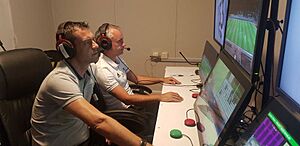
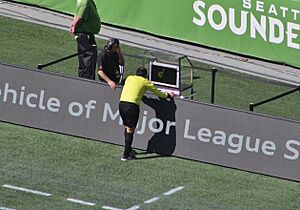
For a long time, FIFA, the world's soccer governing body, did not allow video evidence during matches. They believed that mistakes were part of the game and added to its "fascination." However, they did allow video for later disciplinary actions.
There were many debates about whether to use technology, especially for "goal-line technology" to see if a ball fully crossed the goal line. Famous incidents, like Frank Lampard's disallowed goal in the 2010 FIFA World Cup, sparked more calls for technology.
Finally, in July 2012, FIFA officially allowed (but didn't require) goal-line technology. It was used at the 2014 FIFA World Cup.
In April 2016, Serie A (Italy's top soccer league) began testing video replays. This led to the official use of Video Assistant Referees (VAR) in the 2017–18 season. VAR was then used at a FIFA World Cup for the first time in 2018.
Major League Soccer in the United States also introduced VAR in 2017.
Gridiron Football
In American and Canadian football, instant replay can be used for close or controversial calls. A team's head coach can ask for a review (with limits), or the officials can decide to review a play themselves. However, not all plays can be reviewed, especially most penalty calls.
Rules for instant replay vary slightly between leagues:
- In the National Football League (NFL), coaches get two challenges per game. They can get a third if both challenges are successful. Challenges can only be made on certain plays before the two-minute warning, and the team must have a timeout left.
- The Canadian Football League (CFL) has similar rules but uses a three-minute warning.
- In NCAA football (college), each team gets one challenge, and a second if the first is successful.
- If a challenge is unsuccessful, the team loses a timeout.
High school football rules generally didn't allow replay review until 2019, when some states started allowing it for postseason games.
Field Hockey
In field hockey, the International Hockey Federation allows the match umpire to ask a video umpire for help. This is usually for deciding if a goal was scored correctly or if there was a foul leading up to a goal. The video umpire can confirm if the ball crossed the line or if a foul happened. Sometimes, teams can also ask for a review of a goal, penalty stroke, or penalty corner decision.
Ice Hockey
In ice hockey, a video goal judge reviews replays of goals that are questioned. Since the referee doesn't have TV monitors on the ice, the video goal judge's decision is final for disputed goals. In the NHL, goals can be reviewed for things like: if the puck completely crossed the goal line, if it went in before time expired, if the net was dislodged, if a player used their hand or foot to direct the puck, or if an attacking player used a high stick. The video goal judge also checks the game clock. Most NHL goals are reviewed by officials in a central "Situation Room" in Toronto.
Review Challenges
Since the 2015-16 NHL season, coaches can also challenge certain calls. Each coach gets one challenge per game, which uses up a timeout. Coaches can challenge if a goal should have been disallowed because a player interfered with the goalie, or if a goal was disallowed for goalie interference but should have counted. They can also challenge offside calls. If a challenge for goalie interference is successful, the team keeps its timeout. If an offside challenge is successful, the challenging team gets a minor penalty. Challenges are not allowed in the final minute of regulation or in overtime; in those cases, the Situation Room reviews all goals.
Motorsports
In international motorsport championships, race officials often use instant replay to decide if drivers should be penalized for crashes or mistakes in the pit lane.
NASCAR uses instant replay to help their electronic scoring system. Replays are used to check rules violations and scoring disagreements.
- They help decide winners in very close "photo finish" races.
- They help determine final positions if a race ends early due to weather or other reasons.
- They check if cars entered the pit lane before it was closed or if drivers followed pit road speed limits.
- They help determine the order of cars leaving the pits during a safety car period.
IndyCar also uses instant replay for similar reasons. In a famous 2008 race, computer scoring showed one driver won by a tiny margin, but video replay clearly showed the other driver's car touched the line first, changing the winner.
TV stations also use replays to show viewers crashes in more detail.
Rodeo
The Professional Bull Riders (PBR) started using an instant replay review system in 2006.
A bull rider, another competitor, or a judge can ask for a replay review within 30 seconds of any decision. A competitor can signal to the replay official and explain why they want a review.
The replay official can ask for different camera angles, slow motion, or freeze frames. They use all available technology, including a stopwatch for timing rides if the clock breaks, and a graphic overlay of the official eight-second clock.
Replays are used to check timing, if the rider touched the bull or ground with their free hand, or if the bull fouled the rider. If a review is successful, the decision is changed, and there's no penalty for asking. If it's unsuccessful, the person who asked for the review has to pay a fee, which goes to PBR charities.
Rugby League
Since 1996, rugby league has used video referees. The video referee can be called by the main official to decide if a try (a score) was made. The "video ref" can check for things like knock-ons (dropping the ball forward), offside, obstructions, and if a player went out of bounds. However, they cannot rule on a forward pass because camera angles can make it hard to tell.
Rugby Union
Rugby union started using video referees in 2001. The rules allow the referee to ask a "Television Match Official (TMO)" for help with decisions about scoring a try or a kick at goal. The referee decides when to call the TMO; players or coaches cannot ask for it. If there's a possible foul play, the TMO can alert the referee and start the review.
For a possible try, the referee makes an initial "soft signal" (their best guess) and then asks the TMO to review all available video. The TMO gives "advice and recommendations." The referee should only change their decision if there is "clear and obvious" evidence that the original call was wrong. The referee is the final decision-maker.
Tennis
In tennis, systems like Hawk-Eye and MacCAM use several video cameras to track the ball's path. They can create a computer image of the ball's trajectory and show if it landed in or out. Players can challenge a line judge's call, and the system's calculation is used to decide. Players usually get three unsuccessful challenges per set, plus one more in a tie-break. TV broadcasts also use this footage to replay points even when players don't challenge.
See also
- Photo finish
- Multicam (LSM), a remote controller used for instant replays with XT3 servers.
- Scoreboard § Video board animation


